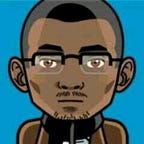Data visualisation begins in your mind
The key to a good visualisation is to ask what your data shows and what makes it interesting to your audience.
Visualisation begins in your mind. This was the underlying message given by Chris Orwa, a data scientist and current Head of Data Science at Brave Venture Labs, to an audience of journalists and technologists at a recent Hacks/Hackers Nairobi (HHNBO) meetup in October.
Orwa’s passion is in digging through massive sets of data, looking for patterns, and asking what these patterns mean. Examples of his work include a look at the wealth structure of the Kenyatta family, which jokes on the Churchill Live show draw the most audience laughter, and figuring out when most people visit shopping malls using parking ticket data.
Orwa often writes about his work on his blog.
For Orwa, the value of data lies not in what it says outright, but rather in the patterns it reveals. For example, when looking at the number of tickets sold at the Imara Daima train station since it opened in 2013, he was able to identify a trend whereby only a third of the passengers who took the train to the city in the morning took the same train back home in the evening. He was able to link this to the fact that the evening train left quite early, when most people would be working.
When it comes to telling a story with data, Orwa says it’s more rewarding to show, rather than to tell. You need to identify the dimensions of your data, as well as the key points of interest, and from there, you can ask what the data shows.
Which is why getting visualisations right is important. These are the graphical representations of your data. They are an interpretation of what the data says, meaning that some creativity is needed in order to design an effective, impactful design.
To illustrate this, consider a table which shows the populations of various cities in several counties of Kenya. Now consider a bar chart with the same data colour-coded by county, This answers two questions in one: which city has the highest population, and which county had the most cities.
Top tips for effective visualisations
Chris had a number of pointers for how to effectively visualise data.
First of all, the questions you should ask need to go beyond the obvious, beyond what the highest and lowest points of the dataset you are looking at.
The best visualizations are often the simple ones. Rather than piling on charts and graphs, you need to identify something that your audience can follow without struggling. Simplification also takes out the problem of ambiguity, where the data leads to different conclusions depending on how you look at it.
Visualisation needs a fine balance between telling as much of your story as possible while taking a minimalist approach. You need to tell a complete story while avoiding overlapping graphics and using as little text as possible.
In order to simplify your graph, you need to limit the number of variables. In a dataset with multiple variables, it is advisable to focus on one or two over time for each story that you do. That way, you make it easier for your audience to follow what the data says and keep track of what you are trying to show as well. You also need to ask interesting questions in order to write an interesting story.
Ultimately, the visualisation should first and foremost be about the data. The tools you use for this are secondary.
The main goal of visualisation is to tell your story in miniature form. You need to answer any questions that your audience might have and provide an answer to them. Let your visualisation complement your story and provide key points of reference so that anyone looking through it understands what you are trying to say.
Now that you know what to do when you’re visualizing data, the next step is to use tools like Datawrapper, Atlas, Tableau Public and other similar tools to give your stories some dimension.
Orwa’s presentation followed on from a talk about liberating data from PDFs and other sources given earlier in the month at HHNBO. To find out about similar meetups in the future sign up for Hacks/Hackers alerts in your area here.
Interested in learning more about data journalism? Sign up for the Code for Africa StoryLab Academy here!
The worlds of hackers and journalists are coming together, as reporting goes digital and internet companies become media empires.
Journalists call themselves “hacks”, someone who can churn out words in any situation. Hackers use the digital equivalent of duct tape to whip out code.
Hacker-journalists try and bridge the two worlds. Hacks/Hackers Africa aims to bring all these people together — those who are working to help people make sense of our world. It’s for hackers exploring technologies to filter and visualise information, and for journalists who use technology to find and tell stories. In the age of information overload and collapse of traditional business models for legacy media, their work has become even more crucial.
Code for Africa, the continent’s largest #OpenData and civic technology initiative, recognises this and is spearheading the establishment of a network of Hacks/Hackers chapters across Africa to help bring together pioneers for collaborative projects and new ventures.
Follow Hacks/Hackers Africa on Twitter and Facebook and join the Hacks/Hackers community group today.
